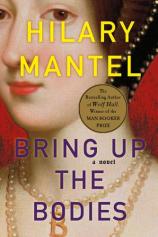Bring Up the Bodies
Review
Bring Up the Bodies
BRING UP THE BODIES won Hilary Mantel the 2012 Man Booker Prize.
This was no easy feat as the subject matter was a retelling of one of the most well-known eras in world history --- the emergence of King Henry VIII of England. To take such popular material and convert to a fictionalized account is a difficult task and one that Mantel took quite seriously. She is purported to have created her own card catalogue of characters and events from this era just to keep things straight. So many people and important alliances pass in and out of these books that only the most detail-oriented author could possibly keep things running coherently.
"Hilary Mantel has created yet another thoroughly engaging piece of historical fiction that will compel all readers to keep turning the pages to see what happens next --- even though the end results are already well known."
In this follow-up novel, BRING UP THE BODIES, Mantel accomplishes greatness once again and takes things even further with the Tudor saga. The front of the book contains not only a character listing but also a family-tree set of charts that astute readers will find themselves constantly flipping back and forth to.
What makes Mantel’s series so interesting is the choice of focusing the events through the eyes and mind of Thomas Cromwell. As advisor to Henry, Cromwell has the precarious duty of attending to his needs as well as juggling all of his appetites --- not the least of which is his desire to have a son and heir at all costs.
This fact makes things quite tense in the castle as Henry’s latest wife, the infamous Anne Boleyn, has yet to produce a male heir for him. Anne supplanted Henry’s previous wife, the very popular Katherine, who is extremely ill and living in exile. She has become a cipher of sorts --- failing to win over the hearts and minds of her “people” and seeing her relationship with Henry falter by the day. As he now sets his obvious next target for Queen on young Jane Seymour of Wolf Hall, Anne realizes that her days may be numbered.
The rumor, however, is that Anne is with child, and this could finally be the male successor Henry so badly desires. Unfortunately, Anne is still referred to as a concubine and great whore with the masses of Henry’s subjects, even doubting that Henry is the sire to Anne’s unborn child. The relationship between Anne and the rest of her court is fraught with distrust and one of the tensest and pivotal plot points of the novel.
All the while, we are forced to find sympathy for the unlikely character of Thomas Cromwell. Historically, Cromwell has not been depicted in a positive light, whether in history texts or in films like The Lion in Winter. Mantel’s Cromwell is a torn and tormented soul who lives with the regret of having helped bring about the executions of Sir Thomas More and Cardinal Wolsey. Now, with the popular tide rising up against Anne, Cromwell finds himself having to align with sworn enemies within the Tudor court to aid in the transition from Anne Bolelyn to Jane Seymour while keeping the King pleased at all times. The cost to Cromwell and his conscience is what drives the narrative and puts the reader right there with him.
Hilary Mantel has created yet another thoroughly engaging piece of historical fiction that will compel all readers to keep turning the pages to see what happens next --- even though the end results are already well known. This ability to create constant intrigue and tension throughout will clearly make BRING UP THE BODIES a contender for literary acclaim in 2012.
Reviewed by Ray Palen on May 11, 2012
Bring Up the Bodies
- Publication Date: May 8, 2012
- Genres: Fiction, Historical Fiction
- Hardcover: 432 pages
- Publisher: Henry Holt and Co.
- ISBN-10: 0805090037
- ISBN-13: 9780805090031





